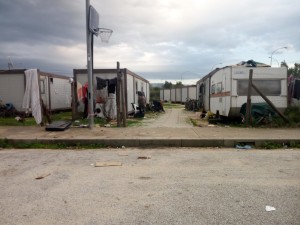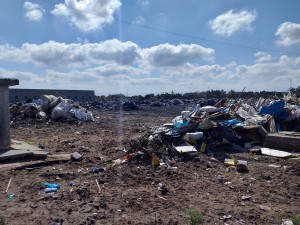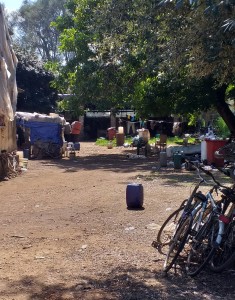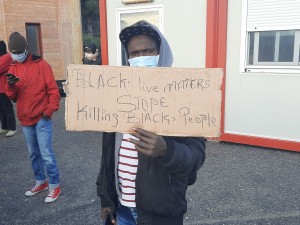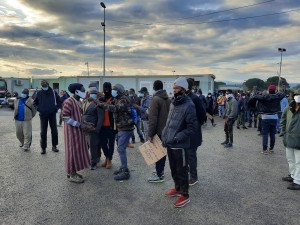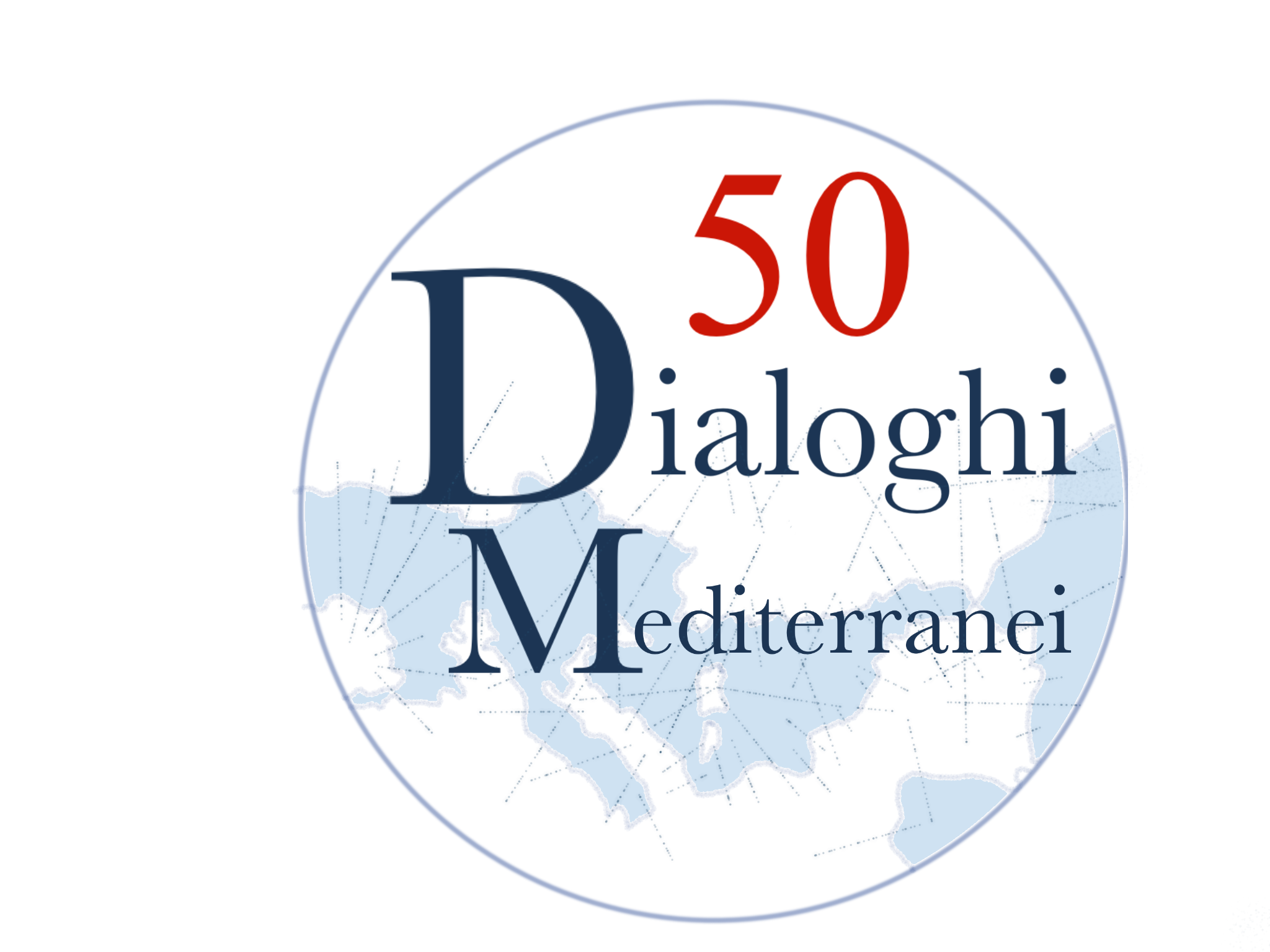di Giovanni Cordova [*]
Introduction
This contribution deals with the impact of Covid-19 on the life of foreign workers living in the Plain of Gioia Tauro, in Calabria, during the so-called “second wave”, which affected Southern Italy regions more harshly than before. This time, in fact, taxes of infection were higher, and pressure over health facilities reached alarming levels. Calabrian small towns and countries that were spared from contagions during the first phase of the pandemic, later knew a very high spread of the virus. Even though the events on which I rely on took place between 2020 and 2021, they are still very current: foreign workers’ living conditions have not improved since then.
During the 2020 autumn-winter season, COVID-19 spread over the tent cities and informal settlements inhabited by migrants in the plain of Gioia Tauro, in the southern Calabrian district of Reggio Calabria. Furthermore, it should be specified that between autumn and winter the presence of migrant seasonal workers in the Plain reaches its peak, due the fact that this is the period dedicated to citrus cultivation, which is the agri-food sector for whom the Plain of Gioia Tauro has been progressively inserted into the geography of migrant work in Italy during the last decades (MEDU 2019; 2020).
The arrival of mass infections in the migrant’s settlements, furtherly exacerbated life conditions in ghettos and tent cities, soon marked by local institutions as ‘red zones’, i.e. sites where enters and leaves are blocked and where internal movement is strictly controlled. Given the impossibility for the local health offices to achieve complete tracking of contagions in the entire Regions and to process regularly Covid-19 tests, the social networks of the infected were addressee of quarantine measure.
For workers without a regular contract, staying confined in a tent meant to be not payed, without the possibility to receive any kind of subsidies from the State. Even those regularly registered by their job-givers, faced big problems. Due to the difficult encountered by local health offices, people resulting negative to the virus after the test did not receive any certificate of negativity, without which they couldn’t leave the ‘red zone’ to go to work. Union trades’ appeal to institutions for an emergency income was ignored.
In such a climate, it’s not surprising that some clashes between ‘trapped’ migrants and police men developed. However, resentment would have led to a great mobilization just a few months later, surprising activists and observers. I am referring of a mobilization whose roots were perhaps less identifiable in socio-political terms, given that it broke out after some accidents occurred to migrants riding their bicycles in the dark and bumpy routes surrounding the tent city of San Ferdinando.
This article is based on ethnographic work I’m conducting in that area since five years, thanks to the collaboration within associations and union trades which are active in the Plain of Gioia Tauro (Cordova 2021) [1]. In the next paragraph, I’ll introduce to the reader some basic features of the presence of foreign workers in the Plain of Gioia Tauro, in Calabria. I’ll try to link this presence to exploitation, the humanitarian reason (Agier 2005; Fassin 2011), and the national political management of migrants, which reflects into local and concrete contexts. Then, I’ll count for the massive, spontaneous and perhaps not at all predictable mobilization of the migrant workers that in December 2020, a few weeks after the peak of the second wave of the new Corona Virus, organized a great strike with an impressive unauthorized parade from the tent city of San Ferdinando to the city of Gioia Tauro. The extent of this mobilization was unexpected by citizens, local political institutions and even union trades and associations that regularly support migrants in the ghettos. After many years of interventions on the ground, in fact, activists that used to invite migrants to strike against exploitation, local patrons and institutional racism without great success, were surprised to see how migrants were able to give shape to a great mobilization in an almost autonomous way.
The Plain of Gioia Tauro between humanitarism and exploitation
During the XX century, the Plain of Gioia Tauro profiled itself on the agrifood market for the citrus cultivation. In the 1980s communities from eastern Europe settled and started working in agriculture until they were replaced by Central and Western African migrants by the begin of third millennium’s new migration waves.
Nowadays, the territory is characterized by deep spatial segregation and isolation. In the towns and the countryside, the large foreign population – which, during the citrus season, exceeds ten thousand people – live mostly in settlements, tents and ghettos detached from centers inhabited by the Italian local population [2]. These settlements are almost ‘irregular’, with the exception of the great tent city of San Ferdinando, a small town overlooking the sea and that progressively became the center of migrants’ presence in the Plain. However, the definition of ‘regular’ and ‘irregular’ is quite fluctuant and dependent on the national and local political interventions. To be exact, ‘legal’ and ‘illegal’ are not two independent spheres; between them it should be identified a relation that sometimes becomes easily evident. This is the case of State intervention on the ghettos after sequences of murders, fires, explosions of gas stoves that periodically take place inside informal and State migrant settlements.
Just think to the great ‘baraccopoli’ or shantytown of San Ferdinando that was cleared in 2018 by the former Minister of Interior, the leader of the Northern League Matteo Salvini. The ghetto resulted from a regular and legal tent city built by the Italian Civil Protection, after the the first great revolt of migrants in the Plain of Gioia Tauro in 2010 against economic exploitation and attacks suffered from local mafia members (Perrotta 2020).
The tent-city became in a few years an uncontrolled site, entirely self-managed by the migrant population, with internal clashes between networks according to different national origins. Foreign and Italian delinquency controlled many dimensions of the social life in the slum (from food distribution to prostitution and drug market).
The 2018 clear, highly mediatized, didn’t provoke serious transformations in the area. Currently, the tent city is still without internal control, given that contract to the local cooperative charged of overseeing the site has not renewed anymore. There is just the presence of the police and a team of firemen parked outside the settlement, called to intervene in case of menace to public order. Local institution have been declaring their will to overcome the ghettos, but this is not the first time they express similar considerations.
To better understand the situation, we should clarify that during the last years, people living in the tent city of San Ferdinando as well as in the other settlements in the Plain of Gioia Tauro are not anymore just agricultural workers. More and more migrants evicted from the hospitality system, due to the growing restrictions in the access to the Italian protection system, join the Plain of Gioia Tauro because they cannot stay elsewhere, following national and local social networks. So, even in summer, where citrus cultivation is interrupted, there are still migrants residing there.
Public discourse about the migrants presence in the Plain of Gioia Tauro emphasizes economic exploitation issues, generally around the almost mythical reference to the ‘caporals’, liminal figures charged to illegally mediate labour force to entrepreneurs and firms. Beyond this focus, however, very little is commonly said about the role of international and national large-scale distribution, accountable for determining low-prices of fruits and vegetable in mass supermarkets, saving charges on agri-food workers and small producers.
Still less is said on the political production of marginality that batters foreign people through the institutional fragmentation of migrant categorizations and the ordinary work of bureaucracy (Herzfeld 1992; De Genova 2002; Pinelli 2013). During the ethnographic work I carried out through the participation within associations and union trades activities, I came across several migrants who were holders of the ‘humanitarian protection’, temporarily abolished in Italy in 2018 after the ‘security-decree’ of national government. Once their stay permit ended, they had to be audited by the Commission that once gave them protection, in order to valuate if they could be assigned other forms of protection, some of them not renewable and not easily convertible in work-permits.
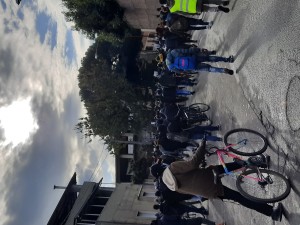
Manifestazione dopo la morte di Gassama Gora. I manifestanti arrivano a Gioia Tauro (ph. Giovanni Cordova)
Confusion was great among migrants, who sometimes were called for auditions with letters sent in places they were anymore present, given the geography of economic mobility within and beyond Italy. Without the renewal of permits, public offices denied them to renew identity cards, residence certifications and other documents necessary to receive welfare services. Many of them were constrained to move to informal settlements, because they didn’t got the documents required to be under contract or to rent a house. Sometimes, their stay permit was going to expire and local police offices refused to start renewal proceedings, until permits really expired.
These structural dynamics have been causing the widening of informal settlements and the ‘informalization’ of the State-tent city of San Ferdinando, where life conditions became in little time very bad.
Right now, the tent-city is abandoned by institutions. But the camp’s regulation formulated by the local administration in 2019 was particularly strict. Holding animals, organizing trade or markets; bringing food from outside are all forbidden activities within the camp. In few words, it’s useful to remind that the moral economy of humanitarian reason assigns priority to people’s sufferance take charge, notably expressed through their bodies and collected through the practice of listening, rather than focusing on political issues and social matters that proactively shape that sufferance (Fassin 2006). Even though the humanitarian reason has been flanked by other kinds of moral economy during last years (just think to racism and the criminalization of solidarity and NGOs active in migrant’s rescuing), its structure remains still visible in camps, especially those managed by State institution. Camps articulate governance of migration within ethical and disciplinary regimes of practices and truth.
In sums, what I would like to underline in this brief space is that sites where the foreign population active in the local agrifood sector is contained in the Plain of Gioia Tauro match the characterization of humanitarian spaces defined by Michel Agier (2008). The French scholar assigns to humanitarian reason and its deployment the three functions of care, cure and control. Even if basic support to migrants became to fail due to the general worsening of the political handling of migration in Italy and the aftermath of pandemics, the aim to care about foreign people was still evident in the San Ferdinando major’s words and in the institutional previsions (destined to fail) to let the tent-city in San Ferdinando a small jewel-hospitality camp. Linked to these objectives, control functions by police, even if ineffective, was strengthened, and security forces operations within migrant settlements were regularly enacted. During the pandemics, law enforcement cut off the illegal connection with water that migrants had made in the ghetto of Contrada Russo, in Taurianova, an informal settlement a few kilometers far from San Ferdinando, a big self-organized site that contained until one thousands of migrants. Controls were also directed to foreign workers while they were reaching their place of work, during the journey from ‘home’. Beyond more visible controls and repression operated by the police, disciplinary vigilance is another mean that affect migrants life in tent cities and camps. Here, guests have to match particular standards of cleaning, hygiene, food consumption, and proper behave, which may reflect a peculiar way of belonging that is expected to reciprocate the hospitality received by host-institutions.
Strictly combined with social control, was institutional abandonment (Pinelli 2013), another common feature of the political handling of migrants in Italy through the bureaucratic delays in providing for answers to migrant requests of protection or permission. Within this ‘grey zone’, migrants inhabit social invisibility. They become visible when they impose violently their vivid and tangible presence outside the seclusion in campaigns and sites far from the city centers. Demonstrations, strikes, and occasions when anger directs political mobilization are other channels through which migrants and foreign workers affirm their physical and political existence with regard to the local population, for once forced to end ignoring them. And it’s to this arrival on the scene of subalterns that we’ll turn our attention now.
Roads to mobilization
The infrastructural pole of the port of Gioia Tauro, dealing with frequent crises that threaten the district work-force, catalyzes expectations and hopes about local and regional development since decades. It symbolizes the mirage of economic and social change that the strengthening of its efficiency within the whole Mediterranean area would transfer to the region and its inhabitants. Beyond the seaport, however, development has lost even mirage’s signs.
Roads linking the towns of the Plain of Gioia Tauro are not traversed by an efficient system of public transports. During last years, road connections saw the progressive disappearance of lighting devices, together with the deterioration of road surface.
This is a problem faced by all the inhabitants of the district. It’s possible to count, in fact, several committees that in recent times have complaint about dangers occurring while moving in the territory. However, problems are still worse for migrants. First of all, they move by bicycle on bad roads in the dark, whenever they reach ‘home’ at the sunset after the work, crossing provincial roads traversed only by cars at full speed. Even if some associations have recently tried to distribute reflective vests and lights for bikes, covering the roads of the Plain is too much dangerous. Secondly, they have the necessity to move around several towns not only due to their work, but also because of the distribution of several offices. For example, a migrant who lives in San Ferdinando must move to Gioia Tauro if he has to apply to the police office; the public health office in Taurianova; the Agenzia delle Entrate (which provides for documents required for different kind of bureaucratic procedures) is found in Palmi. Many African shops are in Rosarno and Gioia Tauro. A few kilometers that is possible to cross just by bicycle (or car, of course), within a geography of mobility that pushes migrant into the public space through quick and dangerous transits.
After the second wave of Covid-19, in a climate of exasperation due to the reasons I mentioned before, accidents occurred to migrants as they were crossing the Plain’s road with their bikes, generating hard resentment among the foreign population. Even if accidents to migrants hit by vehicles, sometimes voluntarily, have always been occurring regularly in recent times, now the indignation aroused with greater intensity. The worsening of the conditions of life in the tent-city and the other settlements and the economic aftermath of pandemics may have increased migrants’ discontent.
However, in December 2020, almost every day, news – sometimes not true – about bad accidents occurring to migrants spread in camps and ghettos, quickly rebounding off of smartphones and phone calls.
On the 21 December, Gassama Gora, a Senegalese guest of the tent city of San Ferdinando, died after having been hit by a car nearby the seaport of Gioia Tauro while he was coming back from work.
In a few hours, the news of the accident went viral among migrants in the Plain. The tent-city dwellers, some of whom were in contact with Italian activists, organized a permanent assembly that lasted the whole night, debating what to do in order to react against a condition that they found not anymore acceptable. They decided to mobilize: the following day they would have organized a demonstration in San Ferdinando, and they also would have abstained from job. That decision was not the quite individual choice of more ‘unionized’ people; rather, it involved the mass of tent city dwellers.
Since many years, union trades have been attempting to organize a former laborers’ strike, considered by activists as the main tool to protest against economic exploitation and inflict a severe blow against the large agro food distribution. However, efforts were always almost wasted. Except a few sit-in organized by union trades in the occurrence of national mobilizations, which always registered a low tax of participation, the work of associations and union trades in the Plain of Gioia Tauro, so important in supporting and defensing migrants with legal desks and mediation with police offices, has not implied active participation into the realm of ‘politics’. That December, things went diversely.
We jointed the tent-city of San Ferdinando in the morning. There were already hundreds of migrants in the forecourt of the site. Many of them hold cartels that said “Black Lives Matter”, “Enough is Enough”, “Stop Killing Black People”. As we arrived, we understood immediately that the mobilization would have been successful. That day, the majority of foreign workers was on strike, and only a few migrants of the tent-city went to work. It was the first time since the 2010 revolt.
The day before, one of the USB union trade’s activist was informed by many of the dwellers that they would have acted something. Situation was incandescent, and to mobilize was also a way to contain many migrants’ hunger. We decided that we would have been there only in order to support them and mediate with the security forces if it was the case. In fact, due to the pandemics, there still were severe limitations concerning public order, and static demonstrations were the only ones to be allowed and authorized by institutions.
Thanks to the mediation of Italian activists with the police, migrants were allowed to act a parade from the tent-city to the road where Gassama dead. The site was not so far from the settlement. Baba, a thirty-year old Senegalese man that, since several months begun to be in contact with the USB union trade, was among the leaders of the parade, holding a megaphone and interfacing with police forces. But he was not the only one. In fact, that event revealed the diversity and plural political sensibilities internal to the migrant front.
Until the parade reached the site where Gassama dead, everything was under control, also because those roads were far from towns. Just a few lorries had to stop sometimes, in order to let the parade cross the roads. Arrived to the site of the accident, however, a group of migrants that Italian activists didn’t know started to suggest excitedly to change itinerary and reach the city of Gioia Tauro, almost 1 hour distant from that place. A violent quarrel arose; some – like Baba – wanted to respect the original path, according to pacts tied with the police. Others, the majority, were not satisfied with ending their demonstration almost silently, far from people, within the invisibility that marked habitually their ordinary life. Italian activists, including me, decided to not interfere with migrants’ decision, reserving the possibility to mediate with the police or, as it would have been the case, with Italian citizens.
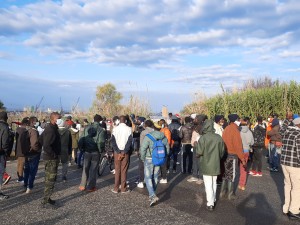
Manifestazione dopo la morte di Gassama Gora. Marcia dalla tendopoli di San Ferdinando (ph. Giovanni Cordova)
I also have to specify, even if in a few words, that during the years in which I’ve been frequenting the Plain of Gioia Tauro, migrants have become disillusioned day-by-day and think that political mobilization is not useful. Even though the presence of union trades and associations is welcomed for the concrete support they give, they are considered unable to produce tangible change on life conditions for foreign people. During some assemblies, someone also explicitly criticized union trades, accusing them for just thinking to “put a flag” in the camps, without engendering any improvement. That’s why the day of the demonstration I am dealing with, they wanted more and would have not settled for just a ‘symbolic’ act.
In a few minutes, the parade changed path, despite police warnings. Migrants occupied the national road that linked Gioia Tauro with San Ferdinando, provoking disease to cars and lorries transporting goods and commodities. While the parade flowed and we encountered migrants who were working in farmhouses, people on the move called them to join the demonstration.
After a long walk, lasted more than one hour, we arrived in Gioia Tauro. As we were in the city, migrants became to run. The arrival was problematic, given that traffic was completely blocked without prior notifications. A few migrants overthrew trash cans and hit cars with hands or sticks, and tension arose with some Italian inhabitants of Gioia Tauro. Harder consequences were prevented by the intervention of an order-service quickly organized by migrants.
While Gioia Tauro’s inhabitants were shocked by that mass of people who were taking possession of the public space, migrants arrived into a central part of the city, occupying a traffic circle, which surrounded many shopping malls. Initially they refused any kind of mediation with institutions. They wanted to show their anger to all the people, and when someone tried to cross the roundabout, even if on foot, they tried to prevent any cross.
In any case, the objectives of the mobilization were at least three, as claimed by Baba at the beginning of the parade. The first, the put in safety of the roads migrant cross every day in conditions of hard danger. Secondly, they required documents, given that the problems and the constraints imposed by laws and bureaucracy make their life impossible. Thirdly, and implicitly evident in the action they acted that day, they affirmed their visibility to a local population that usually ignore them. Being physically present in the streets, paralyzing the traffic and avoiding people to cross the road, they were not skippable anymore.
The migrant front was divided even in that moment of the mobilization. A group was not interested into encountering institutions (like the Prefect or political representatives), and gave shape to several moments of tension with police and Italian people that addressed them abuses. Another faction searched instead a confrontation with institutions. Beyond requesting an encounter to the Minister of Labor, as suggested by Italian union traders, they were convinced to encounter the major of Gioia Tauro. This choice, advocated by the police, that hoped for the end of the demonstration, was criticized by the other protesters and read as the institutions’ effort to weaken the extent of the mobilization.
However, after two hours, the demonstration receded. The more ‘rigorous’ group stayed in the street until the first part of the afternoon, while the other abandoned de facto the mobilization to encounter the major of Gioia Tauro, who in the meanwhile had called some actors of local civic associations and confederal union trades to better sustain the confrontation with migrants. After that the major promised to solicit an intervention by Prefecture and the Minister of Interior – we should keep in mind that matters claimed by migrants were outside of major’s duties – the group came back to the other demonstrators, some of them already gone away.
Adopting a skeptical and pessimistic view, it would be easy to state that the demonstration ended without tangible results, concluding with the usual promises of intervention made by institutions. However, undoubtedly something had made that mobilization very different from the others enacted in the past.
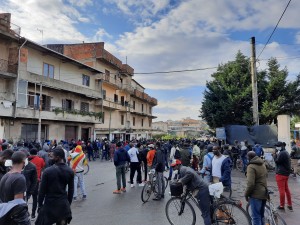
Manifestazione dopo la morte di Gassama Gora. I manifestanti arrivano a Gioia Tauro (ph. Giovanni Cordova).
Conclusions
Since I became to frequent the Plain of Gioia Tauro, for both ethnographic research and supporting associations’ and union trades’ activities, I’ve always observed the efforts made by activists to promote, among migrants, a political framework of the conditions lived by the foreign population of the area. These attempts have not been very successful. If migrants acknowledge to activists great credit for what regards documental or bureaucratic support (aid for stay permits; identity cards; appeals; welfare benefits and so on), their ‘politicization’ has been very hard to achieve. Calls for strikes, demonstrations and lawsuit of job exploitation have taken root only marginally. During the several assemblies I participated, migrants always used to complaint about the inconclusive character of mobilizations, sometimes accusing union traders to just think of “putting their flags” in ghettos and camps. Why should they loose days of work and money if engagement does not bring real change?
Before the pandemics, migrants living in the Plain of Gioia Tauro had to face several constraints: labor exploitation, denials in obtaining papers and documents, difficulties in finding home without “falling in the traps” of ghettos and informal settlements. The political treatment of the foreign population of the Plain has to come to terms with national policies – that in recent years have been becoming always more hostile to migrants – and their local articulation, i.e. the legal and bureaucratic practices ongoing in police and public offices, more than often arbitrary and ‘illegible’ (Das 2004).
The new coronavirus pandemics has deeply worsen life conditions and economic chances in the Plain of Gioia Tauro. The job loss and the impoverishment that hit many foreign workers nourished fear and vulnerability as well as anger and resentment among migrants. Against this background we should frame the echo raised up by a series of road accidents occurred to young foreigners while they were reaching home or their place of work. Even if in the past there already have been similar accidents, this time migrants’ outrage reached very high levels and led them to mobilize successfully within the public space of the Plain of Gioia Tauro. In this episodic mobilization, they self-organized, despite internal divisions and factions, marginally profiting of Italian activist’s aid.
No one expected a so participated demonstration like that of last December, that for the first time since the 2010 revolt reached the residential areas of the Plain, overwhelming Italian people.
Rather than claiming sophisticated political issues, migrants simply asked not to die while going to or returning to work. In a few words, they pretended dignity, as they shouted during their parade. Even if the mobilization didn’t produce clear results (although some of the streets around the Gioia Tauro seaport have recently been object of reworking) and didn’t continue after that day, migrants affirmed their presence in a public space wherein they are almost invisible and silent, like when they ride their bikes in the dark. The effects on the mediatic and political debate in the Plain, however, have been tangible as for weeks institutional meetings were held in the Prefecture of Reggio Calabria.
Activists have been longly reflecting about the reasons for which that time migrants decided to mobilize. Though not proposing definitive or clear explicative patterns, I think it would be useful to turn to James Scott’ concept of moral economy (1976). Subalterns may accept unequal economic and political relations, adhering to a worldview where someone holds the power and others not (even if they can resort to the so called “weapons of the weak”). What is not tolerable, however, is the violation of moral rights, as the right for survival. Unequal social relations may be tolerated, but there’s a threshold which, if surpassed, let the formal acceptation of social order turn into revolt.
Even though James Scott’s reflections derived from his historical and anthropological studies on south-Asian peasants, his intuitions may concur to explain why in ‘normal’ conditions of exploitation and political abandonment, they do not join activists’ mobilizations. Rather, they take action after events whose political significance is apparently less structured – freedom to walk or cross roads without being hit by vehicles.
Social stratification is justified only until power guarantees for minimum social rights. Dying in the dark after a hard working day is a lot worse than being underpaid or hindered in taking an ID card. When it happens, subalterns mobilize entering the scene and, in the general amazement, they have much to say (Scott 2006).
Dialoghi Mediterranei, n. 54, marzo 2022
[*] Abstract
In questo contributo mi focalizzo su una protesta messa a punto durante la seconda ondata pandemica (autunno-inverno 2020) da migranti e lavoratori stranieri della Piana di Gioia Tauro in seguito alla morte di un bracciante senegalese residente nella tendopoli di San Ferdinando. Esasperati da sfruttamento economico, infime condizioni di vita nei ghetti e nei campi della Piana e marginalizzazione politica parimenti alimentata dai dispositivi della ragione umanitaria e da dinamiche di abbandono istituzionale, in quell’occasione la popolazione straniera dell’area si è mobilitata come non avveniva da tempo. Sebbene si tratti di eventi risalenti a più di un anno fa, le riflessioni contenute in questo articolo conservano un certo grado di attualità. Le condizioni di vita nei ghetti e nella tendopoli diffusi tra Rosarno, San Ferdinando e Taurianova non sono affatto migliorate, nonostante gli annunci delle istituzioni locali, regionali e nazionali. Pur in forma sintetica, mi interrogo sulle ragioni che in alcuni casi accelerano inaspettatamente la conflittualità sociale e l’organizzazione di mobilitazioni politico-sindacali perseguite da gruppi sociali ormai sfibrati dall’intersezione di violenza strutturale e sofferenza sociale.
Endnotes
[1] It’s the case of the ‘Nuvola Rossa’ association and the USB union trade.
[2] Even if distinctions are blurred, I refer to ‘ghettos’ to indicate spaces not regulated by State or local institution interventions, in contrast to the tent-city of San Ferdinando. See Lo Cascio, Piro 2015.
Reference List
Agier M. (2005), “Ordini e disordini dell’umanitario. Dalla vittima al soggetto politico”, in Antropologia, 5: 49-65.
Agier M. (2008), Managing the Undesirables: Refugee Camps and Humanitarian Government, Cambridge, Polity Press.
Cordova G. (2021), Fuori dalla città. Ghetti, ospitalità e politiche locali nella Piana di Gioia Tauro, in F. Declich, S. Pitzalis (a cura di), Presenza migrante tra spazi urbani e non urbani. Etnografie su processi, dinamiche e modalità di accoglienza, Milano, Meltemi: 91-117.
Das V. (2004), The Signature of the State. The Paradox of Illegibility, in V. Das, D. Poole, Anthropology in the Margins of the State, Santa Fe, School of American Research Press: 67-91.
De Genova N. (2002), “Migrant “Illegality” and Deportability in Everyday Life”, in Annual Review of Anthropology, 31: 419-447.
Fassin D. (2006), “Un ethos compassionevole. La sofferenza come linguaggio, l’ascolto come politica”, in Antropologia, 8: 93-110.
Fassin D. (2011), Humanitarian Reason: a Moral History of the Present, Chicago, University of Chicago Press.
Herzfeld M. (1992), The Social Production of Indifference, Chicago, The University of Chicago Press.
Lo Cascio M., Piro V (2018), “Ghetti e campi. La produzione istituzionale di marginalità abitativa nelle campagne siciliane”, in Sociologia urbana e rurale, 117: 12-36.
MEDU, Medici per i Diritti Umani (2020), I dannati della terra. Rapporto sulle condizioni di vita e di lavoro dei braccianti stranieri nella Piana di Gioia Tauro.
MEDU, Medici per i Diritti Umani (2020), La pandemia di Rosarno. Emergenza sanitaria e sfruttamento endemico. VII Rapporto sulle condizioni di vita e di lavoro dei braccianti stranieri nella Piana di Gioia Tauro.
Perrotta M. (2020), Rosarno, prima e dopo. Cosa è successo nelle campagne del Sud, Roma, Edizioni dell’asino.
Pinelli B. (2013), “Silenzio dello stato, voce delle donne. Abbandono e sofferenza nell’asilo politico e nella sua assenza”, in Antropologia, 15: 85-108.
Scott J. (1976), The Moral Economy of the Peasant: Rebellion and Subsistence in Southeast Asia, New Haven, Yale University Press.
Scott J. (2006), Il dominio e l’arte della resistenza, Milano, Elèuthera.
____________________________________________________________
Giovanni Cordova, dottorando in ‘Storia, Antropologia, Religioni’ presso l’Università ‘Sapienza’ di Roma, si interessa di processi migratori – con particolare riguardo al sud Italia, società multiculturali e questioni di antropologia politica nel Maghreb. Per la sua ricerca di dottorato sta esaminando la dimensione politica ‘implicita’ nella vita quotidiana dei giovani tunisini delle classi sociali popolari nonché la commistione tra i linguaggi della religione e della politica. Prende parte alla didattica dei moduli di antropologia nei corsi di formazione rivolti a operatori sociali e personale della pubblica amministrazione in Calabria e Sicilia.
_____________________________________________________________



